The Palestinian Arena: The Need to Arrest the Slide into a One-State Reality
Udi Dekel and Noa Shusterman
Trends
Core challenge to national security · The PA is weakened, in advance of Abbas’s exit · Israel buys time while sliding toward a one-state reality · Hamas consolidates its rule in Gaza and sets the tone in the Palestinian arena
The Palestinian Arena: The Need to Arrest the Slide into a One-State Reality
Udi Dekel and Noa Shusterman
Recommendations
Curb the slide into a one-state reality · Seek transitional agreements and separation moves in the West Bank · Strengthen the PA · With Egyptian mediation, seek understandings with Hamas for military quiet · Prepare for terrorism and a military campaign in Gaza
The Palestinian arena presents a core challenge to Israel’s national security. The current government, like its predecessor, seeks to buy time and to postpone weighty strategic decisions on the Palestinian issue. This conflict management strategy has four consequences. One: Increased potential for weakening the Palestinian Authority’s governance and legitimacy, which could intensify in advance of “the day after Mahmoud Abbas,” thus leading to a rise in terrorism and the lack of a responsible Palestinian leadership. The background to this situation is the absence of a political horizon, the disruption of agreement-based dynamics, and the growing complexity given the entanglement of the Palestinian and Jewish populations in the West Bank and the steep slide toward a one-state reality. Two: Ongoing Hamas efforts to consolidate its rule in the Gaza Strip, while challenging the Palestinian Authority’s leadership and striving to undermine PA control in the West Bank. Three: The relative indifference in the international and regional systems to the Palestinian issue and the lack of pressure to induce political progress enhance the frustration of those in the Palestinian camp who adhere to the path of political solutions and increase the motivation to choose the path of “resistance” – terrorism and violence. Four: Despite the prevailing sense that there is no feasible political solution in the short and medium terms, the Palestinian issue continues to be at the core of the political divide in Israel, heightening the tension between Jews and Arabs in Israel and Arab residents of East Jerusalem, and could damage relations with the Democratic administration in the United States. Consequently, in 2022 the Palestinian arena will likely demand military and political attention, compounding the challenges of a nuclear-driven Iran and those in the northern arena.
The central challenge: Restoring agreement-based dynamics and curbing the continued descent into a one-state reality. To this end, it is necessary to formulate an up-to-date strategy for the Palestinian arena that should be centered on a political, civil, and economic foundation of transitional agreements to strengthen the legitimacy and performance of the Palestinian Authority. In addition, Israel should consider a civil-economic plan for the Gaza Strip with the aid of the Gulf states and Egypt, and condition it on both a halt to Hamas’s military buildup and gradual strengthening involvement of the Palestinian Authority.
Political Stagnation and Outbreaks of Violence and Terrorism
Several events in 2021 turned the spotlight back toward the Palestinian arena, reflecting a growing distance from agreement-based dynamics; turbulence in the Palestinian Authority’s governance system; instability; and an increase in terrorism and violence.
The inauguration of US President Joe Biden breathed new hope into the Palestinian Authority leadership, which supports a political process with Israel. For the PA, the end of President Trump’s term removed the “deal of the century” from the agenda, given that the Biden administration supports the traditional positions favoring a two-state solution. However, the basic guidelines of the Israeli government formed in May 2021 include maintaining the status quo in the Palestinian arena, meaning postponing political progress but also postponing unilateral annexation, and at most implementing economic development measures. Gaps between the White House and the Israeli government emerged following the Biden administration’s demand that Israel refrain from taking steps on the ground that would obstruct a two-state solution – in particular, continued construction in the West Bank and East Jerusalem – and Israel’s opposition to an American consulate for Palestinians in Jerusalem (East or West). Nonetheless, the administration, in contrast to Palestinian expectations, does not intend, at least at this stage, to use its weight to launch a political process.
In early 2021 Palestinian Authority President Mahmoud Abbas declared that elections to the Palestinian parliament would be held in May, in accordance with a plan agreed upon with Hamas. The idea of elections arose in reconciliation talks between Fatah and Hamas, which were accelerated by the isolation imposed on them by the Trump administration, the “deal of the century,” and the Abraham Accords. Abbas sought to demonstrate a positive approach toward the Biden administration and the European countries, which have long demanded that elections be held within the PA as a condition for continued economic support. When it became clear to Abbas in April that his movement, Fatah, faced a downfall, he canceled the elections, claiming that Israel did not allow them to be held in East Jerusalem.
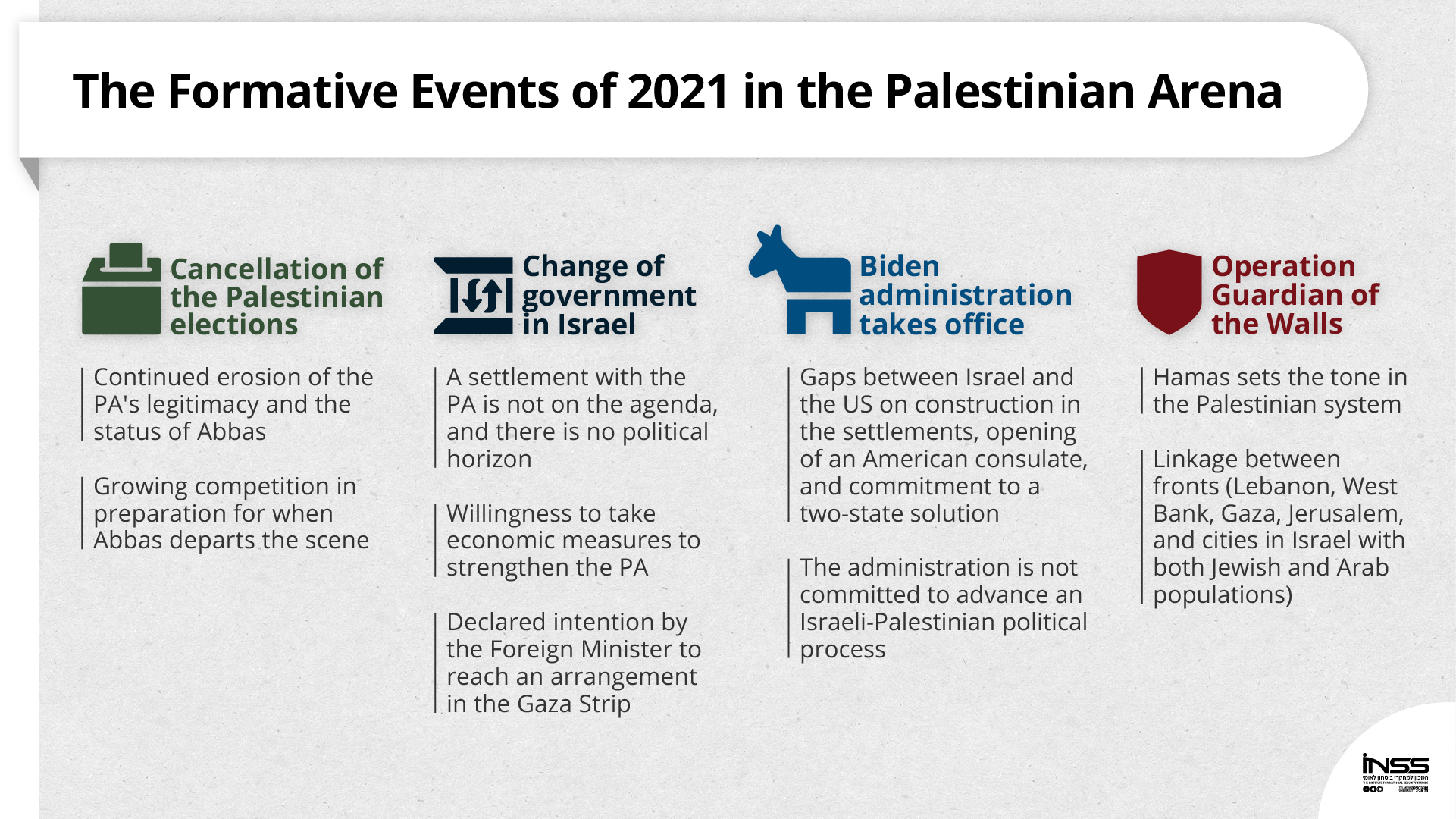
The cancellation of the elections joined a series of violent events in Jerusalem that prompted Hamas to launch rockets toward Jerusalem, having identified an opportunity to achieve a leading status in the Palestinian camp. The rocket fire led to another round of conflict between Israel and Hamas, Operation Guardian of the Walls in May 2021. The military campaign took place in two parallel spheres. While Israel focused on the kinetic dimension to attain tactical military achievements, and mainly to strike and destroy Hamas military infrastructure and demand “quiet in return for quiet,” Hamas focused on the cognitive dimension and scored a strategic achievement: it positioned itself as the defender of al-Aqsa and Jerusalem; demonstrated that it leads the Palestinian camp – “if there are no elections then we’ll set the street on fire”; launched barrages of rockets deep into Israeli territory without the IDF succeeding in stopping them; stirred up Arab residents in cities in Israel with mixed Arab and Jewish populations; provoked riots in the West Bank; and succeeded in encouraging the launching of rockets at Israel from South Lebanon.
By six months after the campaign, Hamas succeeded in restoring the situation in Gaza to its former state and even improving it – the movement of goods into Gaza has been eased, work in Israel is permitted (for 10,000 workers/merchants), the Qatari bankroll has been restored, including to Hamas employees, and a plan has been formulated for reconstructing the Gaza Strip. In a poll conducted among the Palestinian public in June 2021 by the Palestinian Center for Policy and Survey Research (PCPSR), 59 percent stated that they would vote for Ismail Haniyeh if he ran against Mahmoud Abbas, who received only 27 percent support. Fifty-three percent thought that Hamas should represent and lead the Palestinian camp, and only 13 percent responded that Fatah should continue in this role. In a poll conducted by the Institute for National Security Studies (INSS), in response to the question “Who won in Operation Guardian of the Walls?” a minority of the Israeli public, 32 percent, answered that it was an Israeli victory; 44 percent that it was a “tie”; 15 percent said that both sides lost; and 8 percent thought that Hamas had won.
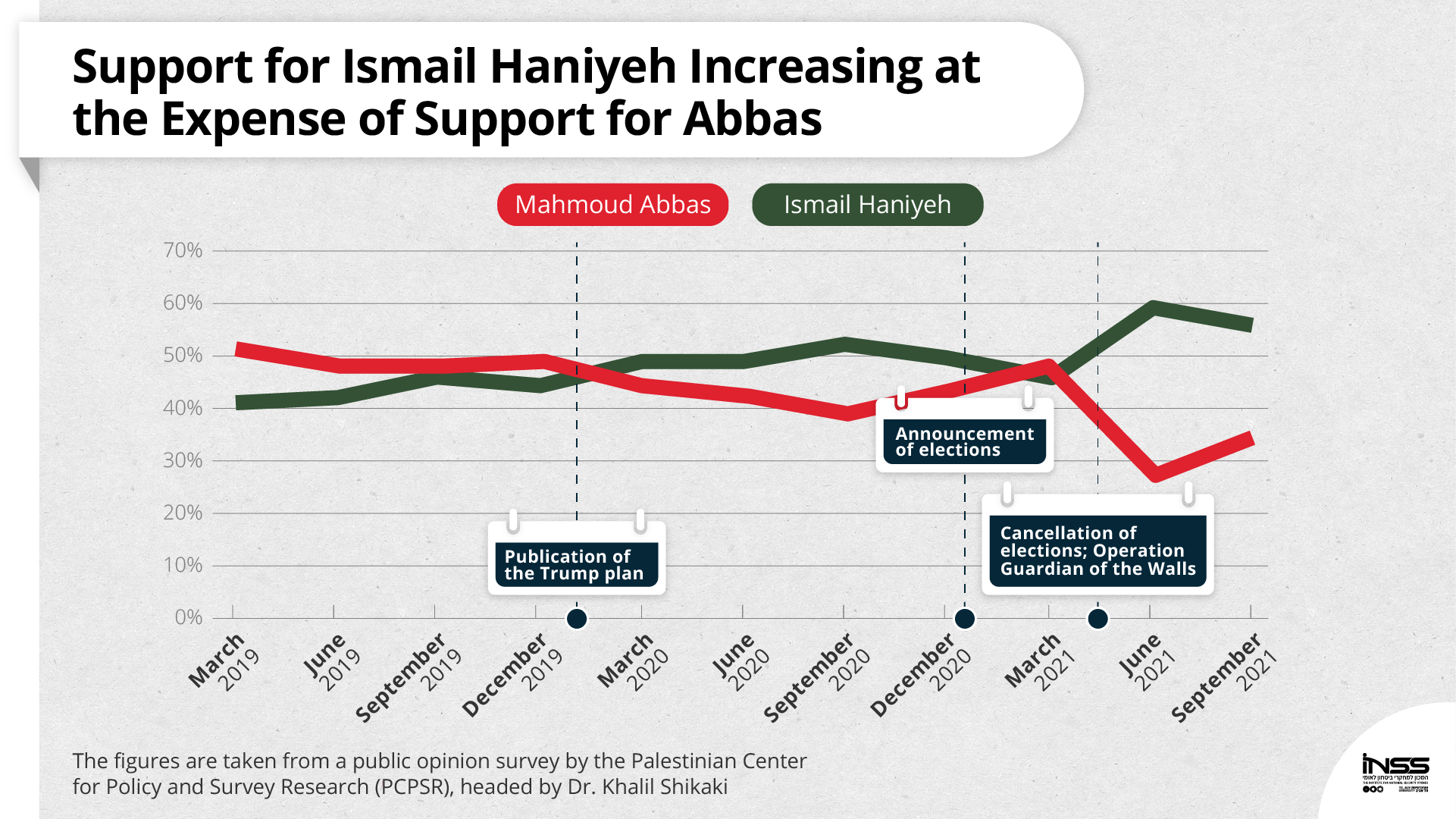
East Jerusalem continues to evolve as the epicenter of the conflict. Toward the end of the year, a wave of attacks by individuals hit Jerusalem and the West Bank. These included a shooting attack in the Old City (one Israeli was killed), a shooting attack at a vehicle close to Homesh in northern Samaria (one Israeli was killed), a car-ramming attack at the Te’enim checkpoint, and five stabbing attacks in Jerusalem. Palestinian elements relate to the attackers as “martyrs executed by Israel.” Hamas is exploiting the atmosphere of escalation and fomenting continued and increased attacks. Meanwhile, there have been more incidents of stone throwing and Molotov cocktails thrown at vehicles traveling on roads in the West Bank and violent incidents between Palestinians and residents of the settlements.
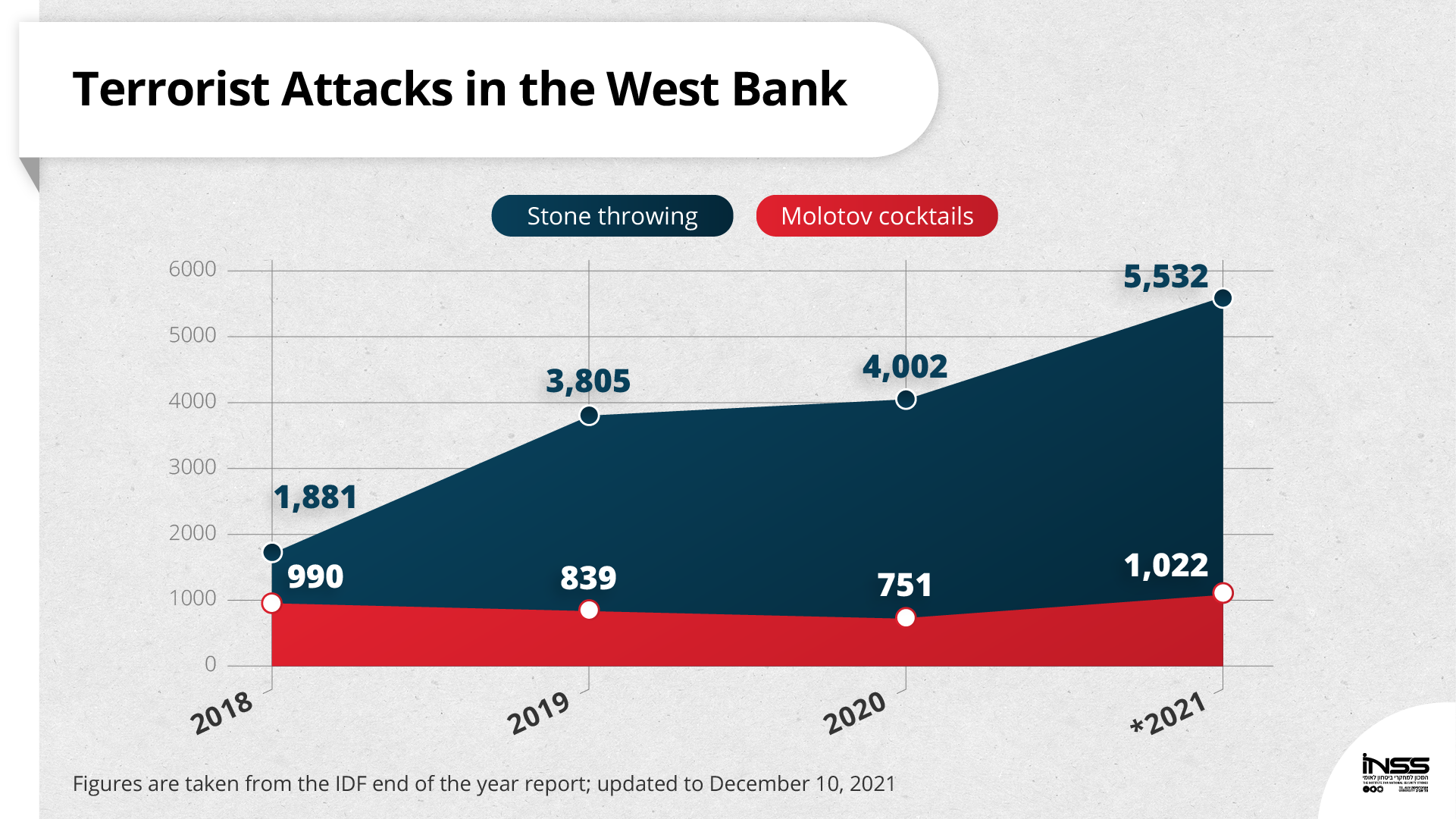
The Palestinian Authority: Weakened but Surviving
Concomitant with the strengthening of Hamas, the crisis of the Palestinian Authority’s stature and its ability to function has deteriorated. Compounding the cancellation of the elections and Operation Guardian of the Walls was the death of human rights activist Nizar Banat in June, which sparked a wave of demonstrations within PA territory; these in turn were forcefully suppressed by the Palestinian security forces, which inflamed the riots. Clearly the Palestinian public, and in particular young people, are tired of the dictatorial rule of Abbas and the corrupt PA, which in their view collaborates with Israel. Hamas and other actors have identified this PA weakness and are working to take control of the Palestinian street. Consequently, the PA’s forces began a campaign to restore governance, but this requires a prolonged and persistent effort and it is not clear whether the PA is fully committed to it. The increasing friction and tension are heightened by actions, sometimes violent, between extremist Jewish groups and Palestinians in Area C under the banner of “the struggle over Area C,” as well as an increasing effort by the Civil Administration at monitoring and demolishing illegal Palestinian edifices.
Above all hovers the question of “the day after Abbas.” Coalitions and alliances of potential successors form and unravel, each backed by armed militias and preparing themselves for Abbas’s departure from the scene. Abbas himself is aware of his weakness and is increasing the antagonistic political campaign against Israel, accusing it of war crimes on numerous international stages and hinting that the PLO will withdraw from the Oslo Accords, thereby ending its recognition of the State of Israel within the pre-1967 borders, and will seek to realize the idea of “Greater Palestine.” In addition, Abbas has rejected any initiative to integrate the Palestinian Authority in economic, technological, and energy projects. In his view, the purpose of the initiatives – in particular those emerging from the Abraham Accords, which the Palestinians vehemently oppose – is to replace the political process. The PA accuses the Gulf states of enabling Israel to advance a strategy of “economic peace” without a political horizon, and thereby help perpetuate the occupation and remove responsibility for the situation from Israel’s shoulders.
Despite its deteriorating situation, the PA is not collapsing, as there are many people within and outside its ranks with vested interests who benefit from it and are committed to its existence, including hundreds of thousands of Palestinians and their families who work in Israel or in the Palestinian public sector. The relative stability in the West Bank is helped by the security coordination between the PA’s security forces and the IDF, the ongoing campaign to dismantle terrorist infrastructure (“mowing the lawn”), and maintenance of the fabric of Palestinian life. In addition, despite its problems and failings, the PA is the only Palestinian body that has international recognition. That said, the more the Palestinian Authority’s standing continues to erode, its status as a future partner for an agreement is undermined, and its ability to implement agreements and understandings and maintain security calm becomes more tenuous.
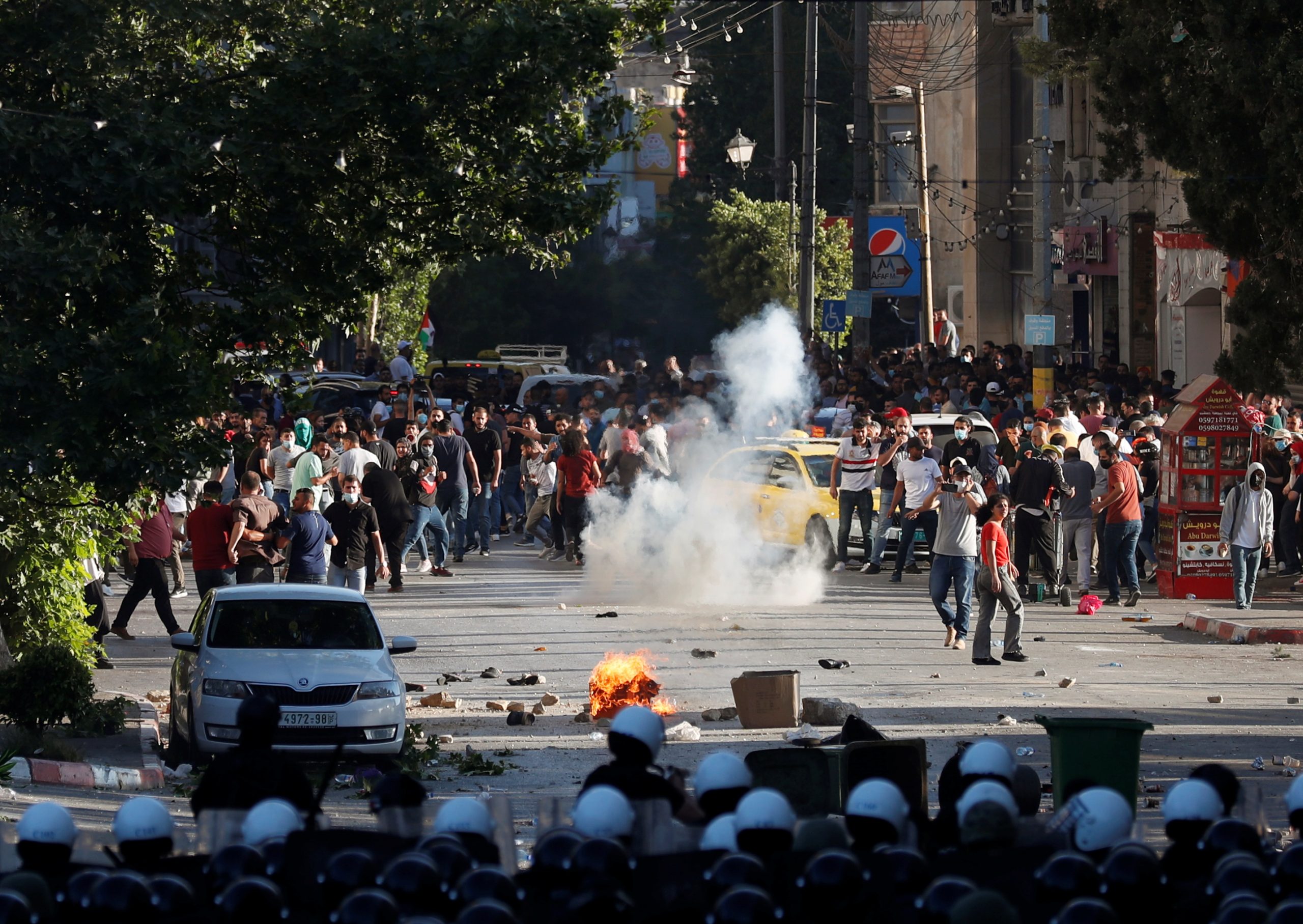
Protests in the PA suppressed with an iron fist. Protest following the death of human rights activist Nizar Banat
Photo: REUTERS/Mohamad Torokman
Israel’s Focus on the Gaza Strip
After Operation Guardian of the Walls, the change of government in Israel, and the completion of the security barrier around the Gaza Strip, Foreign Minister Yair Lapid unveiled his “economy for security” plan, thus signaling Israel’s willingness to advance toward an arrangement in the Gaza Strip. While the government has declared that the reconstruction of Gaza will be conditioned on halting Hamas’s military buildup and resolving the issue of the captured and missing Israelis, it is evident that the Israeli leadership understands that insisting on these conditions would tie its hands in a way that harms its own interests, which center on stabilizing Gaza. Egypt for its part sees achieving understandings for a five-year ceasefire between Hamas and Israel and the integration of Egyptian companies in projects to reconstruct the Gaza Strip as a way to underscore its potential as an asset in the eyes of the Biden administration and the international community, and as leverage to improve its influence to restrain Hamas.
The current Israeli policy appears to return the situation in Gaza to the days before Operation Guardian of the Walls, yet Hamas is even stronger and more dominant, and Israel does not have tools to obstruct its military buildup. Furthermore, since the operation Hamas has implemented a dual resistance strategy – calm in the Gaza Strip alongside development of terrorist infrastructure and incitement in Jerusalem, in the West Bank, and South Lebanon. Hamas is expected to continue to balance between the various identities – religious, national, civil, and resistance – as long as these serve its various goals. Any process toward an arrangement in the Gaza Strip thus recognizes Hamas’s legitimacy and strengthens it, including acceptance of the dual resistance strategy. A necessary corollary is the weakening of the Palestinian Authority, its standing, and its political course.
Deepening Economic Crisis
The PA territory has experienced a gradual recovery from the economic crisis caused by the COVID-19 pandemic, but the PA government is confronted with a serious deficit as a result of a decline in foreign aid and the devaluation of the dollar relative to the shekel, which increases the Palestinian dependence on tax transfers from Israel. It is possible that a strengthened shekel will have a positive impact on the Palestinian cost of living, as reforms implemented recently on imports increase the purchasing power of the shekel and enable the import of products from abroad at reduced prices. However, rising prices of fuel and food and global supply chain disruptions could reduce the positive impact. In addition, in 2021 there was a significant increase in the number of Palestinians employed in Israel, but the total income of the employees, which amounts to 21 percent of the PA’s GDP, is barely taxed. This employment has a negative impact on the employment of Arab men who are citizens of Israel, which has already declined in recent years. In addition, corruption is a significant growth inhibitor in the PA, e.g., illegal sales of permits to work in Israel, the lack of competition stemming from the coupling between those with financial interests and their connections to the PA leadership, and the lack of a functioning judicial system.
The Gaza Strip economy has not yet recovered from the COVID-19 pandemic and GDP is even lower than before the crisis. The international community’s reconstruction efforts led by Egypt have advanced, but the economy itself is meager with low added value and a shortage of capital due to years of low investment. There are few manufacturing industries in the Gaza Strip, and hence an expansion of permits to export from Gaza to Israel or to other economies is not expected to lead to a considerable increase in exports. Israel recently approved “merchant permits” from Gaza for work in Israel and later raised the number of work permits from 7,000 to 10,000, with most Gazans in Israel working unofficially as day laborers, not merchants. From the perspective of the security establishment, the entry permits to Israel are a tool for stabilizing the military situation between Israel and the Gaza Strip, but economically they have only a slight effect on Gaza’s economy. Despite the attractiveness of working in Israel in terms of the level of income, this is not a reality-changing tool; it has a marginal impact on employment and unemployment rates due to the size of Gaza’s work force.
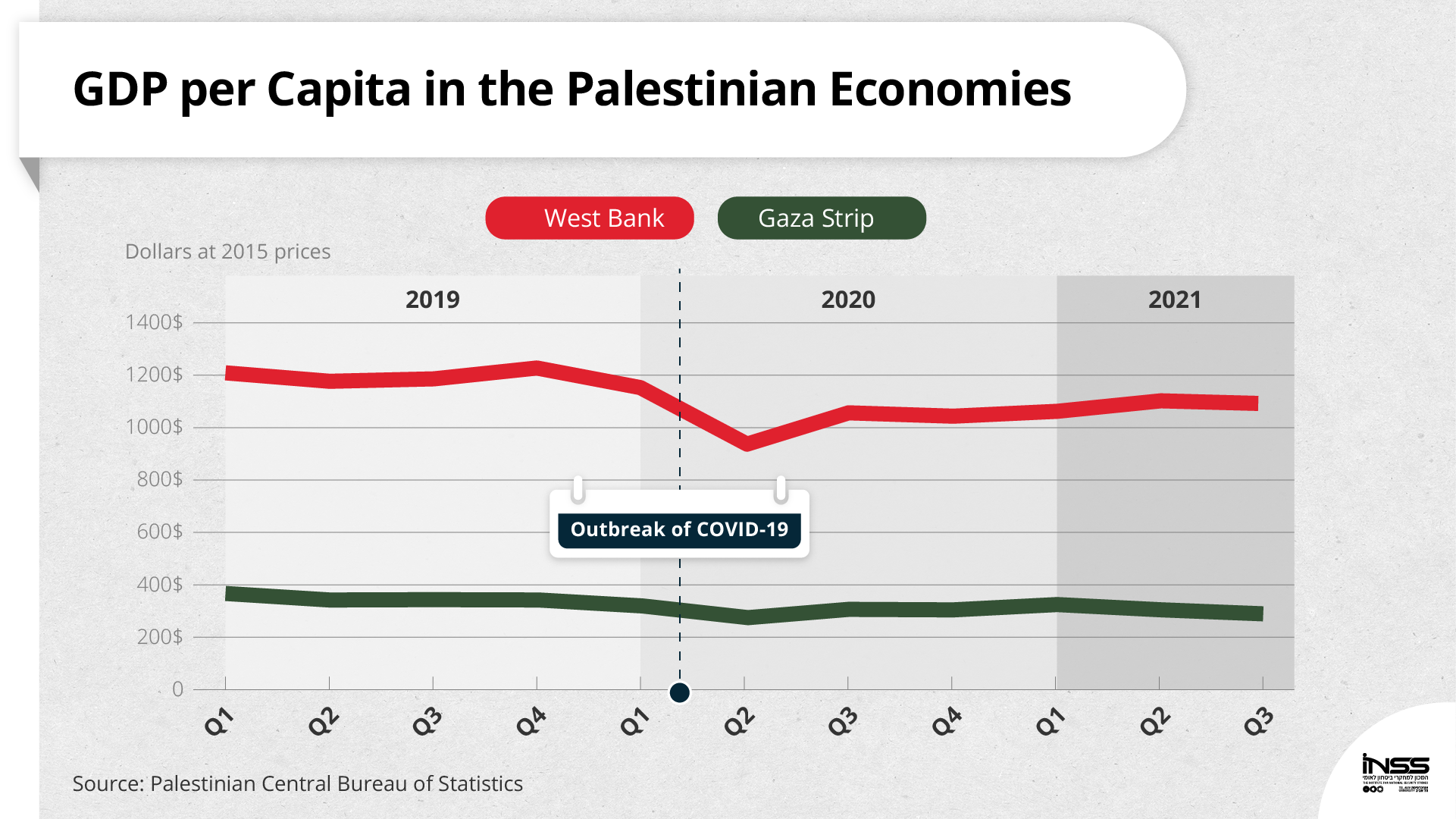
Conclusion and Recommendations
A central strategic problem for Israel is that conditions on the ground are moving away from those that enable a political solution to the Israeli-Palestinian conflict. The current government, like its predecessor, seeks to buy time and postpone strategic decisions on the Palestinian issue. The implication is a slow, almost unfelt, slide into a one-state reality, despite the widespread understanding among the public and the majority of political elements that this reality endangers the Zionist idea and the ultimate aim of a Jewish, democratic, secure, and moral state. Findings from an Institute for National Security Studies (INSS) survey show that about 60 percent of the public thinks that the State of Israel should take steps now to separate from the Palestinians in order to prevent a reality of a single binational state.
The main factors leading toward a one-state reality are: the lack of a political horizon; “deals” with Hamas above the head of the Palestinian Authority, thereby weakening it as a partner for a future agreement; construction in settlements outside of the settlement blocs and east of the security barrier, and the legitimization of unauthorized outposts, which will make separation between the populations much more difficult; a significant increase in work permits in Israel for Palestinian workers, their direct employment by Israeli employers, and their integration within the Israeli economy; connection and unification of water, electricity, communication, and transportation grids, which increase mutual dependence; prevention of open transit between the PA and Jordan; perception of all of the territory west of Jordan as a unified security zone under Israel’s control.
The basic premise underlying Israel’s policy in the Palestinian arena should be the need to confront two separate and competing Palestinian entities.
- With respect to Hamas, Israel currently aspires to formulate understandings for a prolonged period of calm in return for the reconstruction of Gaza and lightened closure, while encouraging increased Egyptian involvement. This alternative is not stable because it does not address the problem of Hamas’s military buildup, an agreement on the captured and missing Israelis is not in the realm of attainment, and it is subject to Hamas’s whims, which vacillate between pragmatism and resistance. Consequently, Israel and the IDF must improve preparedness for a military operation that aims to dismantle Hamas’s military capabilities and ongoing conflict management, because the vectors are pointing in these directions. At the same time, in order to restrain Hamas, Israel should make efforts to involve the Gulf states (the United Arab Emirates and Saudi Arabia) in projects to rebuild Gaza – natural gas supply as a green energy source, desalination of sea water, sewage infrastructure, and the establishment of employment centers – that will be run under Egyptian leadership and reduce the senior standing of Qatar.
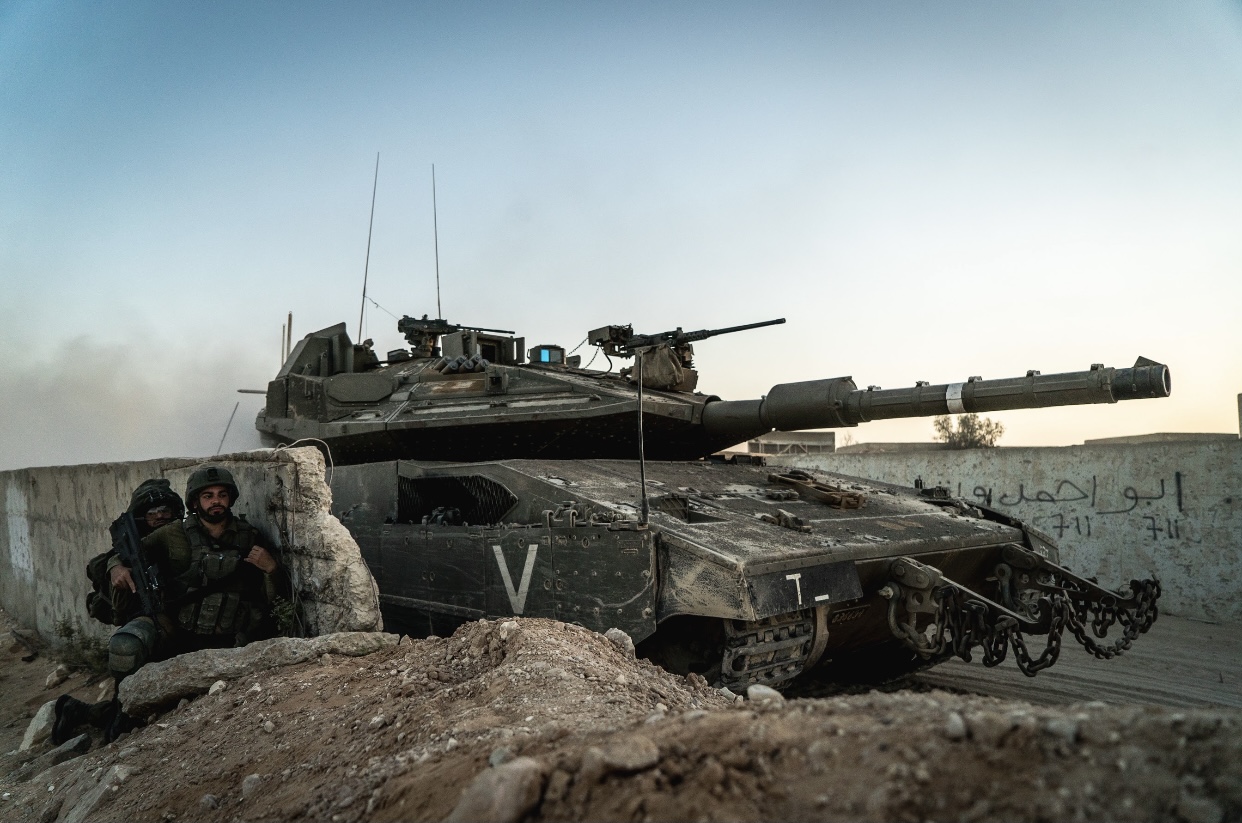
The need to improve preparedness for a military campaign. IDF deployment on the Gaza border during Operation Guardian of the Walls
Photo: IDF Spokesperson’s Unit (CC BY-SA 2.0)
- With respect to the Palestinian Authority, there should be an effort to strengthen it in order to maintain stability in the West Bank and as part of a strategic plan to maintain the dominance of agreement-based dynamics and stop the slide into a one-state reality. To this end, Israel should work in four spheres:
- Transitional arrangements for a period of 3-5 years, or understandings (without written agreements) on cooperation with the Palestinian Authority. The aim: a gradual and developing process of improving the law and order, economic, and civil situation and the PA’s governance capability. To that end: maintain ongoing discourse with PA representatives; expand the realm of arrangements on a wide variety of issues, big and small, and implement them on the ground immediately; recognize the PA as a legitimate partner and prefer it over the nationalist Islamic stream that is not oriented toward peace; strengthen the standing of the Palestinian security apparatuses in enforcing law and order in Areas B and C; establish a designated dock for the PA at the Ashdod Port with train tracks to the crossings at Tarqumiya and Erez; approve the placement of Palestinian customs agents at the ports and at the Allenby Crossing for Palestinian goods; increase the operating hours and the capacity of goods transfers at the Allenby Crossing; advance green energy, environmental, water, and climate projects; aid in recruiting international support for the PA; evince willingness to reopen discussion of some of the articles of the Paris Protocol; take decisive action to prevent violence between Jews and Palestinians.
- Start to implement steps toward separation, with a preference for coordination with the Palestinian Authority, but also possibly independently. In this context: refrain from building outside of the blocs and especially in areas that prevent separation; upgrade Palestinian status at the crossings (including Allenby); issue permits for building economic infrastructure for Palestinians in Area C; legalize Palestinian construction that spills over into Area C and change its status to B (such that 99 percent of the Palestinian population will live under the responsibility of the PA); rebuild and complete the security barrier to close breaches.
- Maintain the “keys” to security in the hands of the IDF, with continued freedom of operation throughout the West Bank to the Jordan River, as an ongoing campaign to prevent attacks and dismantle terrorist infrastructure, while maintaining cooperation with the PA’s security apparatuses. Agree with the PA that the more its security forces operate with determination to dismantle terrorist infrastructure and prevent attacks, the more Israel will be able to reduce the profile of its activity on the ground.
- Recruit the support of the Gulf countries, Egypt, and Jordan to provide guarantees to the Palestinian Authority for its willingness to cooperate and to help build infrastructure for an independent Palestinian state, and initiate joint regional projects of the PA with Israel, Egypt, Jordan and the Gulf countries in the fields of green energy, water, technology, and climate.
- Special attention is required for the issue of Jerusalem, a sensitive point where all of the conflict’s components – national, religious, historical, emotional, symbolic, security, and civil – converge. It is important to continue to develop East Jerusalem, including with improved infrastructure, more schools and preschools, and more places of employment for the local population. Construction in E1 and Atarot should be postponed, while opposing the opening of an American consulate in West Jerusalem; on the Temple Mount, the status quo should be maintained and the standing of Jordan as a restraining element should be strengthened; it is recommended to examine the establishment of an Arab Muslim advisory committee led by Jordan. In Sheikh Jarrah and Silwan, Israel should strive for solutions that enable the Palestinian residents to remain in their homes.
Anat Kurz, Pnina Sharvit Baruch, Kobi Michael, Oded Eran, Yohanan Tzoreff, and Haggay Etkes participated in the preparation of the situation assessment.
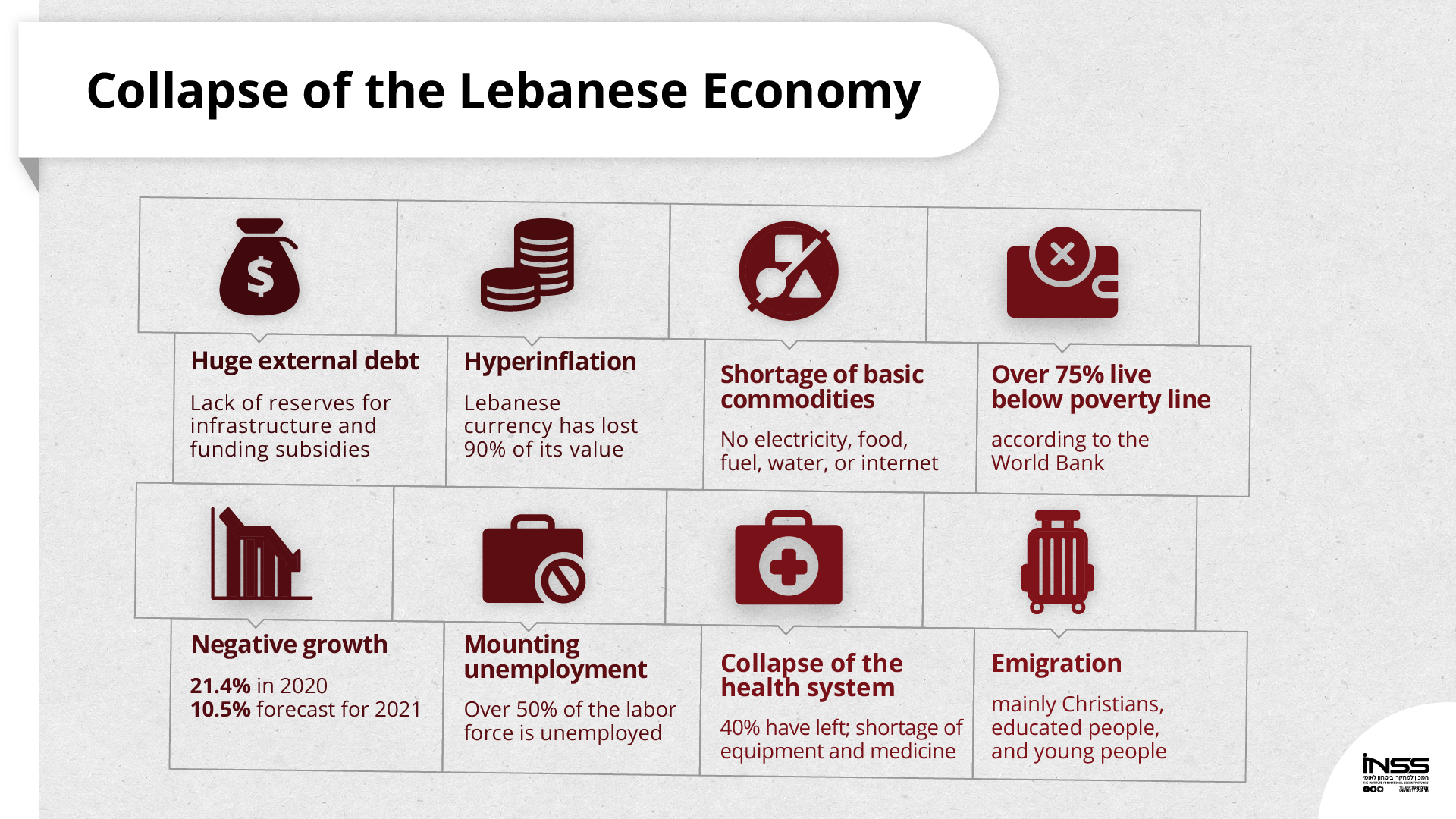
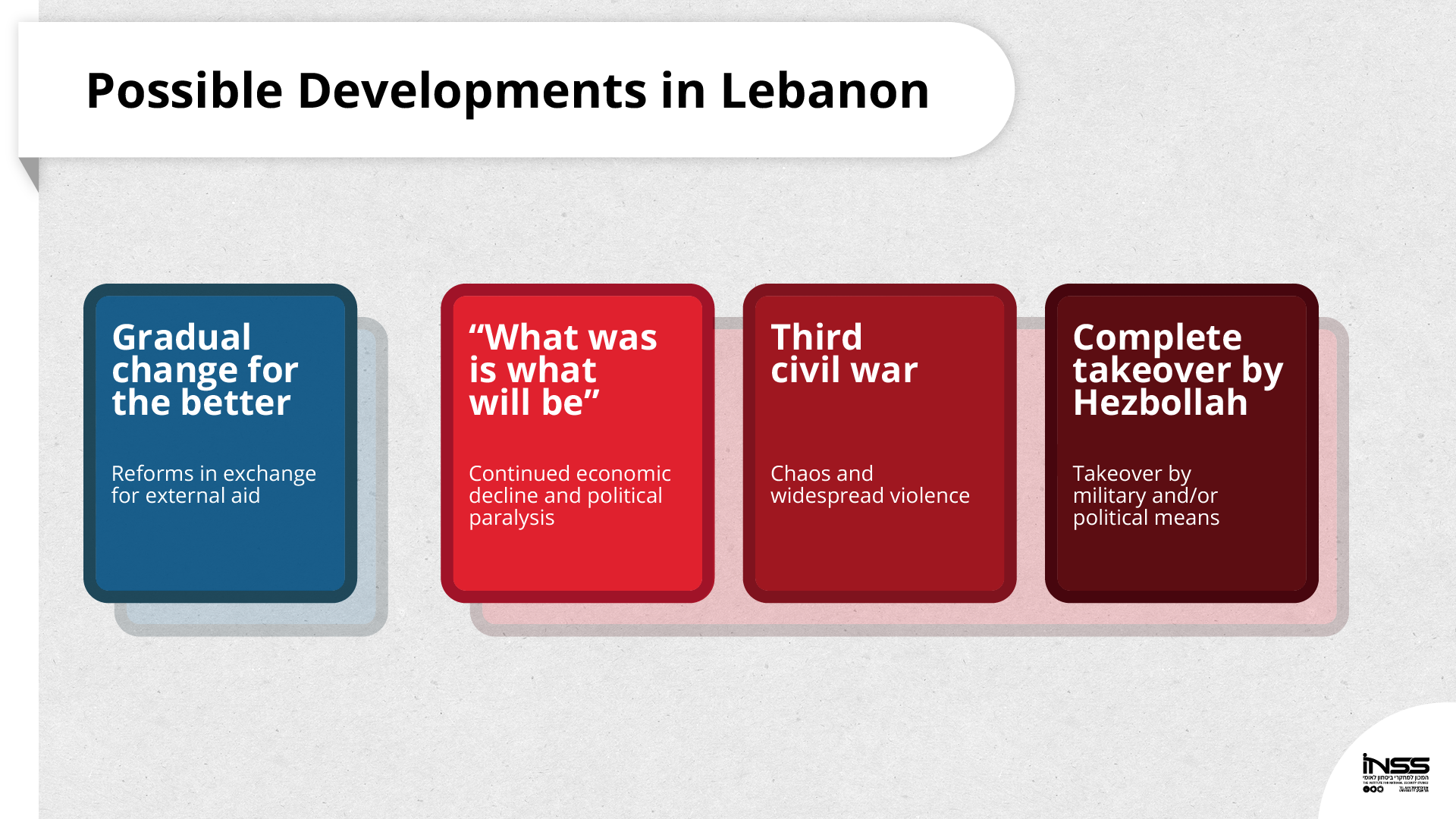
Policy Recommendations: Syria and Lebanon
The Assad regime will likely not succeed in gaining control of all parts of Syria in 2022, and will not expel Iran and its proxies from the country. Iran will persist in its multidimensional efforts to consolidate its presence in the country and preserve its influence there; transfer weapons to Hezbollah in Lebanon, with an emphasis on precision components for missiles and rockets and attack unmanned aerial vehicle in Syria and Lebanon; and build offensive capabilities against Israel from Lebanon, Syria, and western Iraq. Hezbollah will maintain its growing influence in Lebanon in all dimensions – political, military, economic, and social – despite the growing internal and external pressure on it. The chances of a significant change in the political order in Lebanon following the parliamentary elections scheduled for 2022 are slim, at best.
The response – implementation of a dual policy – emphasis on independent actions by Israel, along with willingness to cooperate with regional allies and positive local groups.
The Self-Reliance Approach
Given the situation in what is in effect a divided Syria, with the Assad regime unable to take control of the entire country, it is important to identify local allies – local communities in southern Syria, leaders of the Druze community in the Suwayda district, Kurds in eastern Syria – open a dialogue with them, and provide them with direct and indirect humanitarian aid. It is also recommended, in cooperation with local power groups, to encourage efforts to oppose the consolidation of the Iranian presence and that of its proxies and Hezbollah’s freedom of action in Syria. In order to win their confidence, it is important for Israel to refrain from officially recognizing the Assad regime, even implicitly.
Israel should persist in its prolonged campaign between wars to push Iran and its proxies out of Syria, with an emphasis on southern Syria. This requires adapting the campaign to the unfolding challenges and expanding the special and clandestine operations against Iranian strongholds in Syria and against groups cooperating with Iran and Hezbollah, including in the Syrian army and among the Syrian intelligence agencies. The Assad regime should be prevented from rebuilding its chemical weapons and transferring them to Hezbollah in Lebanon. At the same time, air defense systems liable to restrict the Israel Air Force’s freedom of action in the airspace of Syria and Lebanon should be neutralized.
Strategic and military coordination with Russia, a leading power in Syria capable of limiting both the IDF’s freedom of action in the Syrian airspace and the extent of Iranian military consolidation, should be maintained. This will require expansion of the strategic dialogue with Moscow, while deepening operational coordination in order to prevent friction with Russian military forces.
It is necessary to prepare operational options for attacking the precision missiles project in Lebanon, among them an outline for a preemptive strike – taking advantage of an escalation event with Hezbollah to attack the precision infrastructure and air defense batteries in Lebanon. At the same time, it is necessary to improve readiness and preparedness for a dynamic of escalation in developments that are liable to lead to war on the northern front, despite the mutual interest in keeping such events below the war threshold.
It is recommended to devise a channel for exchanging messages with the Assad regime, in parallel with the coordination mechanism with Russia, in order to facilitate control of the war arena in accordance with Israel’s needs – confining it exclusively to the Lebanese front or expanding it to Syria and western Iraq.
A Multilateral Cooperative Approach
An effort should be made to induce the Gulf states, Jordan, and Egypt to make normalization with the Assad regime contingent on reducing the influence of Iran and Hezbollah, with an emphasis on preventing their deployment in southern Syria. Cooperation with Jordan should be strengthened in supporting groups in southern Syria opposed to Iranian entrenchment and Hezbollah operations in the area.
The tripartite coordination between the United States, Russia, and Israel should be strengthened, in the realization that Syria’s future depends on agreements and coordination between Russia and the United States. Israel should encourage the Biden administration to be more flexible toward Russia in order to achieve mutual understandings on thwarting Iran’s negative influence in the region. At the same time, it is necessary to promote an understanding in the region and throughout the world of the negative consequences of the activity by Iran and its proxies, which destabilize this theater. Intelligence connections, diplomatic dialogue, and influence efforts should be employed in this campaign. The objective is to encourage international coordination, with a focus on weakening Iran and Hezbollah and limiting subversion by the Shiite axis. Special emphasis lies on a possible return to the nuclear agreement and the removal of the sanctions against Iran, which will enable it to devote large resources to support its proxies and rogue actors throughout the region. It is recommended to establish a mechanism for consulting with the United States, the Gulf states, Jordan, and Egypt on restraining the negative Iranian influence and formulating alternatives to Iranian support in Syria and Lebanon.
With respect to the failing Lebanese state, there is a clear preference for preserving the country, in other words, not remaining indifferent, and taking action to delay/prevent its collapse. The existing situation of multiple ruling centers in Lebanon and the system of balances between them (though flawed), based on the Taif Agreement, is preferable to a complete takeover of the country by Hezbollah in the service of Iran. For this purpose, a broad-based coalition of countries should be formed, led by the United States, France, and Saudi Arabia, to send humanitarian aid directly to the Lebanese population and aid in the restoration of functioning state systems. At the same time, an international coalition should be formed in an effort to restrict the influence of Iran and Hezbollah, and to strengthen Hezbollah’s opponents in Lebanon. For its part, Israel can demonstrate flexibility in the discussion of the maritime border, including arrangements on the supply of energy, inter alia from the disputed maritime areas.


